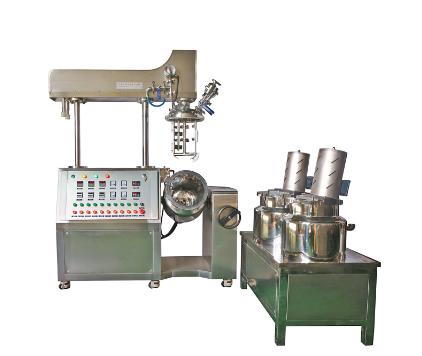1. Daily cleaning and hygiene of the emulsifier.
2. Electrical equipment maintenance: ensure that the equipment and electrical control system are clean and hygienic, and do a good job of moisture-proof and anti-corrosion. If this aspect is not done well, it may have a great impact on electrical equipment, or even burn out electrical equipment. (Note: Turn off the main brake before electrical maintenance, padlock it on the electrical box, and do safety signs and safety protection work).
3. Heating system: The safety valve should be checked regularly to prevent the valve from rusting and contamination failure, and the steam trap should be checked regularly to prevent debris from clogging.
4. Vacuum system: The vacuum system, especially the water ring vacuum pump, sometimes burns the motor due to rust or debris during use, so it is necessary to check whether there is any blockage in the daily maintenance process; the water ring system should be kept Open. During the starting process of the vacuum pump, if there is a blockage phenomenon, the vacuum pump should be stopped immediately, and the vacuum pump should be cleaned and then restarted.
5. Sealing system: The emulsifier has a large number of seals. The static ring and the static ring should be replaced regularly for the mechanical seal. The circulation is the frequent use of the equipment. The double-headed mechanical seal should check the cooling system frequently to avoid the failure of cooling and burn out the mechanical seal; the skeleton; For the seal, select the appropriate material according to the characteristics of the material, and replace it regularly according to the maintenance manual during use.
6. Lubrication: Motors and reducers should be regularly replaced with lubricating oil according to the manual. If they are used frequently, the viscosity and acidity of the lubricating oil should be checked in advance, and the lubricating oil should be replaced in advance.
7. During the use of the equipment, the user must regularly send the instruments and meters to the relevant departments for verification to ensure the safety of the equipment. 8. If abnormal sound or other failure occurs during the operation of the emulsifier, it should be stopped immediately for inspection, and then run after troubleshooting.

The reason why the temperature of the emulsifier does not go up
Emulsifiers are machines that can fully refine and evenly distribute materials. Emulsifiers can efficiently, rapidly and uniformly partition one or more phases into another continuous phase, but generally, each phase is immiscible. Due to the high tangential speed and the strong kinetic energy brought by the high-frequency mechanical effect generated by the high-speed rotation of the rotor, the material is subjected to strong mechanical and hydraulic shearing, centrifugal extrusion, liquid layer friction and impact in the corresponding mature technology and appropriate additives. Under the joint action, under the action of tearing and turbulent flow, the combination of liquid phase and gas phase will immediately disperse and emulsify uniformly and finely, and obtain stable and high-quality products through high-frequency circulation.
1. There is a problem with the heating power supply of the heating motor of the emulsifier.
2. The heat absorption rate of the material in the stainless steel reactor is too fast, much higher than the external heating rate, so the temperature in the reactor cannot keep rising.
3. The heating wire of the important part of the stainless steel reactor is disconnected. Maybe the reason is simple, the built-in heating plate is damaged, causing the temperature not to rise.
4. The heating controller of the computer equipment is damaged, so that the user cannot visually see the temperature heating.
Post time: Nov-05-2022




